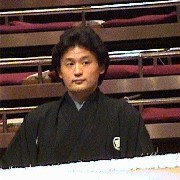| Brothers in Sumo – part one Brian Lewin |
 |
NHK & the Ozumo
English Broadcast
Mark Buckton
A visit to NHK, years of watching the show and the opinions of our Ed-in-Chief
Hanging With the Rikishi
Barbara Ann Klein
Barbara Ann Klein recounts her experiences with the “boys” in a pictorial diary series
| Rikishi of Old Joe Kuroda |
 |
Sumo Exhibit at the
Edo-Tokyo Museum
Barbara Ann Klein
SFM’s Editor takes in the exhibit celebrating 80 years of the Japan Sumo Association at this famous Tokyo museum
| Heya Peek John Gunning |
 |
| SFM Interview Dave Wiggins sits down |
 |
Photo Bonanza
What a collection – All-Japan Sumo Tournament, Hakkaku-
beya visit and sumo exhibits at the Edo-Tokyo Museum
Kyushu Basho Review
Lon Howard
Lon gives us his Kyushu Basho summary, along with the henka sightings results, and his take on the year in brief
Lower Division Rikishi
Mikko Mattila
Mikko Mattila covers lower division ups and downs
| Hatsu Basho Forecast Pierre Wohlleben & Mark Buckton |
 |
Sumo 101
Eric Blair
Eric explains all you need to know and then some about the Kokugikan building – the mecca of sumo
| Kimarite Focus Mikko Mattila |
 |
Minusha
John McTague
John’s unique bimonthly view of news from outside the dohyo
Online Gaming
Eric Blair
For the lowdown on Guess the Kotomitsuki – baby of SFM’s John Gunning
Kokugi Connections
Todd Lambert
Todd’s bimonthly focus on 3 of the most interesting sumo sites today
| Fan Debate Intra heya bouts – |
 |
SFM Cartoons
Stephen Thompson
In the second of our cartoon bonanzas, sit back and enjoy ST’s offerings
Let’s Hear From You
What was it that made you a sumo fan? American Todd Defoe tells all
Readers’ Letters
See what SFM readers had to say since our last issue
Sumo Quiz
The Quizmaster
Answer the Qs and win yourself next basho’s banzuke.
The next sign of trouble would come after three more historical achievements, beginning in September 1993, when Waka joined his brother to make the first brother ozeki duo in sumo history. About two years later in the 1995 Kyushu basho, they made history in a different way, when they competed in the first sibling playoff for the makuuchi yusho. Waka won the match, which he would later describe as the most painful thing he ever had to do in sumo. Two and a half years later, Waka would rise again to meet his brother, creating the first brother yokozuna after winning his second consecutive yusho at the 1998 Natsu basho. Not long after that point, believing that his elder brother was slacking off after having made the rank,

Takanohana-oyakata
Things eventually thawed out a bit, particularly after Wakanohana retired in March 2000 and, leaving the sumo world, became Hanada Masaru again. But even then it was an uneasy peace, and Takanohana’s retirement in the 2003 Hatsu basho did little to warm things up further.
Just how uneasy would come to light in events over these past
Then, the inevitable happened. On May 30th of this year, Hanada Mitsuru succumbed to his illnesses and passed away. Unfortunately, instead of bringing the family together, the death seemed to have the exact opposite effect, with the two brothers having a very vocal and public dispute over funeral arrangements, the estate and other matters. In the end, Masaru made some statements and gestures apparently aimed at restoring the peace, but there was some question as to his sincerity and motivation, particularly from his brother, who has thus far rejected those overtures.
Next Home
